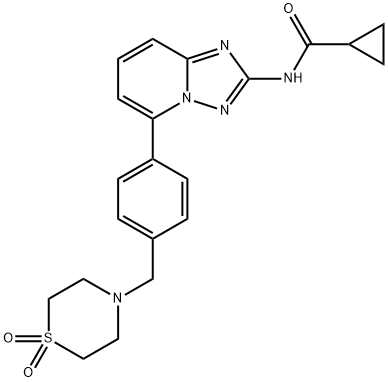COMPUTED DESCRIPTORS
| Molecular Weight | 425.5 g/mol |
|---|---|
| XLogP3 | 1.4 |
| Hydrogen Bond Donor Count | 1 |
| Hydrogen Bond Acceptor Count | 6 |
| Rotatable Bond Count | 5 |
| Exact Mass | 425.15216079 g/mol |
| Monoisotopic Mass | 425.15216079 g/mol |
| Topological Polar Surface Area | 105 Ų |
| Heavy Atom Count | 30 |
| Formal Charge | 0 |
| Complexity | 715 |
| Isotope Atom Count | 0 |
| Defined Atom Stereocenter Count | 0 |
| Undefined Atom Stereocenter Count | 0 |
| Defined Bond Stereocenter Count | 0 |
| Undefined Bond Stereocenter Count | 0 |
| Covalently-Bonded Unit Count | 1 |
| Compound Is Canonicalized | Yes |
PRODUCT INTRODUCTION
description
Rheumatoid arthritis (RA) is a chronic, autoimmune, systemic, and inflammatory disease that causes synovial joint symptoms and can limit range of motion in severe cases. The disease is associated with extra-articular manifestations, progressive disability, and comorbidities including cardiovascular disease and mental disorders. 50-70% of patients with RA are unable to achieve sustained clinical remission despite the availability of several treatments including disease-modifying anti-rheumatic drugs (DMARDS) like [methotrexate], interleukin-6 (IL-6) blockers, and tumor necrosis factor (TNF) inhibitors. New therapeutic developments target other inflammatory pathways implicated in RA including the Janus kinase (JAK) signaling pathway as seen with filgotinib. There are four JAK subtypes which include JAK1, JAK2, JAK3, and tyrosine kinase 2. Non-selective JAK inhibitors like [tofacitinib] target JAK1 and JAK3 subtypes with minimal activity at JAK2. In contrast, the newly approved filgotinib is a highly selective JAK1 inhibitor. JAK2 and JAK3 play important roles in both immune and hematologic functions; therefore, selectivity for JAK1 aims to improve the safety profile of filgotinib while maintaining clinical efficacy. Filgotinib is currently reserved for patients who cannot tolerate DMARDs, or who have been unable to achieve remission in response to one or more DMARDs.
